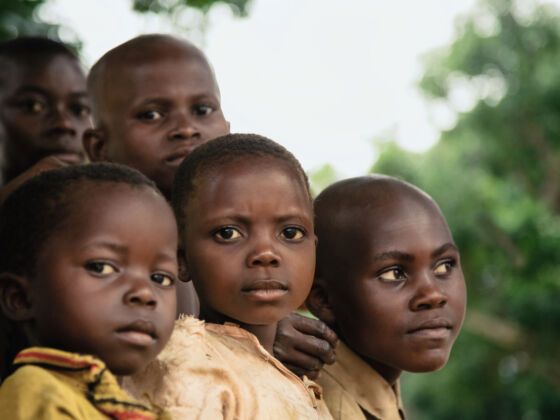The Central African Republic is quite possibly the most unstable and least-governed country on the continent. It was ruled by the crazed, self-declared emperor Bokassa, whose coronation involved a gold throne paid for by France, and who once personally murdered one of his ministers in a fashion Le Monde described as “so revolting that it still makes one’s flesh creep.”

Failed State of Mind: Kristen Van Schie in the Central African Republic
It’s been mostly downhill from there, with the country’s most recent and barely reported coup in March triggering a growing humanitarian situation that very few journalists have covered. I spoke about it with Kristen van Schie, a South Africa-based reporter for The Star newspaper in Johannesburg. Because she went.
KVS: In March this year, a group of rebels marched south and took over the country in a coup. Nothing of extraordinary interest for our South African audience there — except for the 15 South African soldiers who were killed in battle defending the capital, Bangui. Which, you know, was a little weird given that the CAR isn’t exactly close by and we weren’t part of any international mission based in the country.
It caused quite an uproar back home — what the hell were we doing there? Why weren’t we properly equipped? Whose business interests are we protecting? It all got very angry and very snarky and was debated in Parliament and then…well, it was largely forgotten. With all our soldiers since withdrawn, why pay attention, right? It was like we all forgot there was a freaking coup. I wanted to know what happened to the local population after that day the South Africans were killed.
So, where is the CAR exactly? Central Africa, presumably…?
When the story first broke about the coup, we had to pull up Google Maps to find the CAR. We’re talking about a country that shares the same name as a region and whose acronym makes for rubbish search results. So imagine the places you HAVE heard of: South Sudan, the Democratic Republic of Congo, the other Congo, Chad. The CAR is wedged in between the lot of them, just north of the equator. It’s one of the poorest countries in the world and fulfills just about every stereotype of Africa I don’t want to write: coups (many), dictators (one accused of cannibalism), nepotism, poverty, underdevelopment, illness, aid organisations, child soldiers.
Shit. And when you got there, what stood out?
The deserted villages on the roads between towns. The villages in the CAR all seem to be built parallel to the roads, so you see just about the whole village sitting outside as you drive past. If you wave at them, the villagers break out in big smiles and shout, “Merci!”
But certain provinces — Ouham in particular — have been shattered by violence, a combination of former rebels and marauding cattle herders passing through the area and setting villages on fire. As you drive along, the villages become emptier and emptier. Then, deserted. Then, destroyed.
What do you bring with you on an assignment like that? Anything you wish you’d remembered later, or didn’t need?
I’m big on writing detailed, longform features, so the most important thing for me to pack is notebooks. Many of them. And pens. I bring all the pens.
I shoot stills and video on my Canon 7D, with a 15-85mm lens. On this trip I also borrowed an incredibly dodgy tripod from a colleague that stuck so badly I gave up using it. My Dell Inspiron laptop is far too heavy and far too slow. The top cover is scratched from a fence in Somalia and the motherboard got fried during a power surge in Syria. Somehow, it still makes its way into my backpack every time.
A Moleskine journal is a must for me on these trips. It’s hipsterish and affectatious and I don’t even keep a journal in real life, but when I’m on missions like this one, I want to record everything I’m feeling and thinking and seeing.
Malaria medication, and the sunscreen it demands. Two of the doctors and just about every villager I met was ill. Trust in the pills, man. The essential: adaptors, chargers, wetwipes, a medicine bottle of washing powder, Imodium.
And what should I have brought? A proper phone cover. Goddamn if my screen wasn’t wreaked after six hours on a dirt road.
What was the situation there like?
I was in the CAR about a month after some pretty awful violence had affected several towns. It was that Christian/Muslim violence you’re hearing about now, though nobody was saying “genocide” just yet. In Bouca, there were displaced people on both sides, Muslim and Christian. Both hurt. Both homeless. Both hungry. Both living just metres from their burnt homes.
The situation was tense. Authority figures and aid organisations in the town were working to keep things calm, to remind everyone that just a month before they lived peacefully. The NGOs were providing medical care, tarpaulins, food handouts, secondhand clothes. But there was a palpable concern that my reporting might set things off again.
What can people back home do to support the work being done in the CAR?
There’s no shortage of aid organisations working in the CAR. Unicef does work with schooling and rehabilitating child soldiers. Doctors Without Borders provides medical care to some of the most isolated areas. The ICRC multitasks with water, housing, sanitation, medical care — the lot. Save the Children. International Medical Corps. International Rescue Committee. They’re all there. Donate to any of these and you’ll be helping them help the CAR.